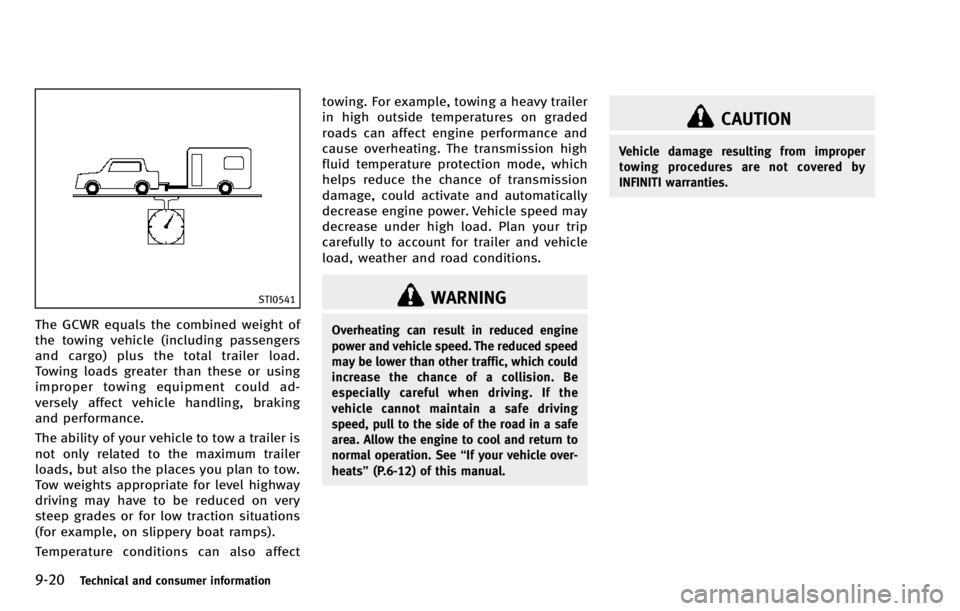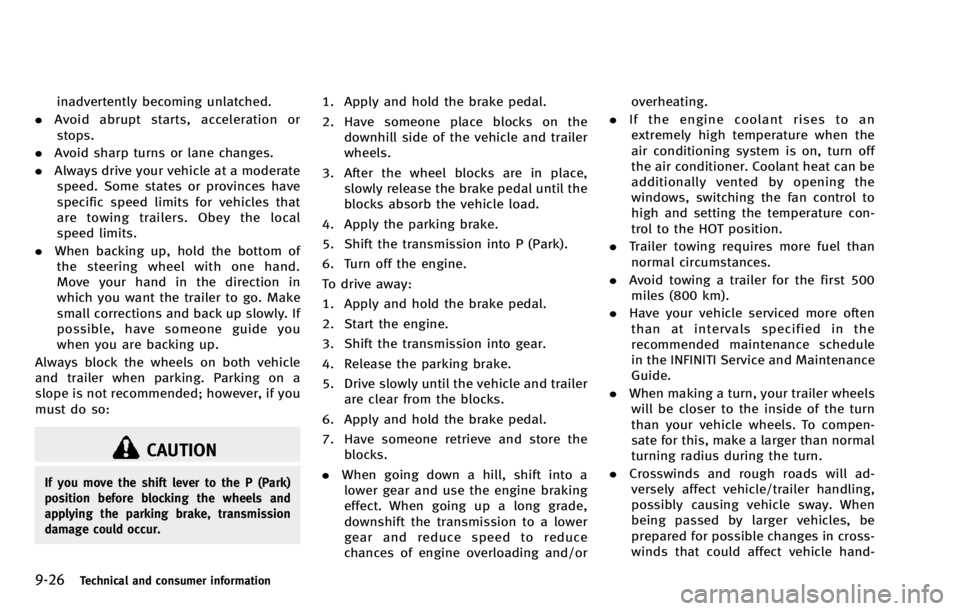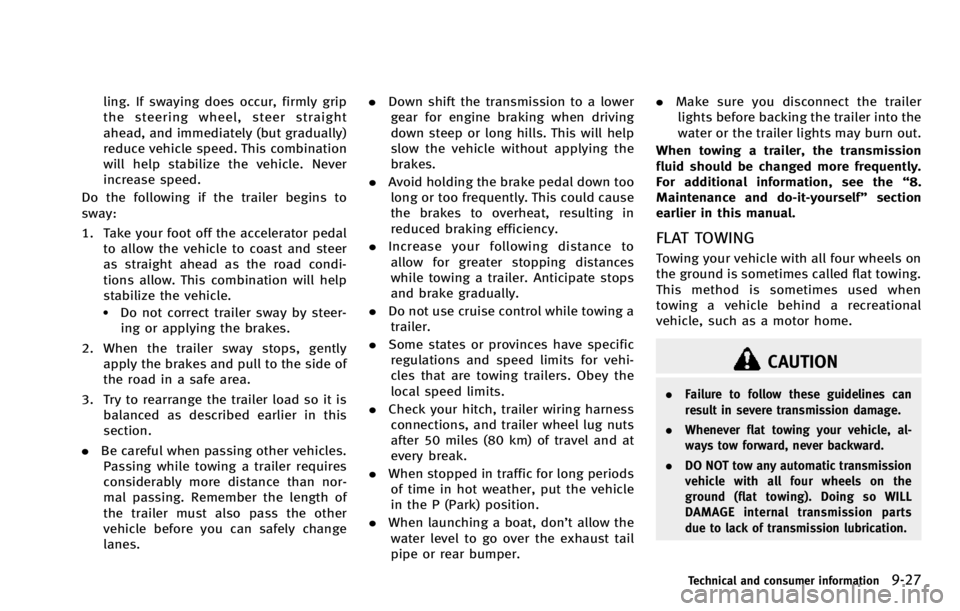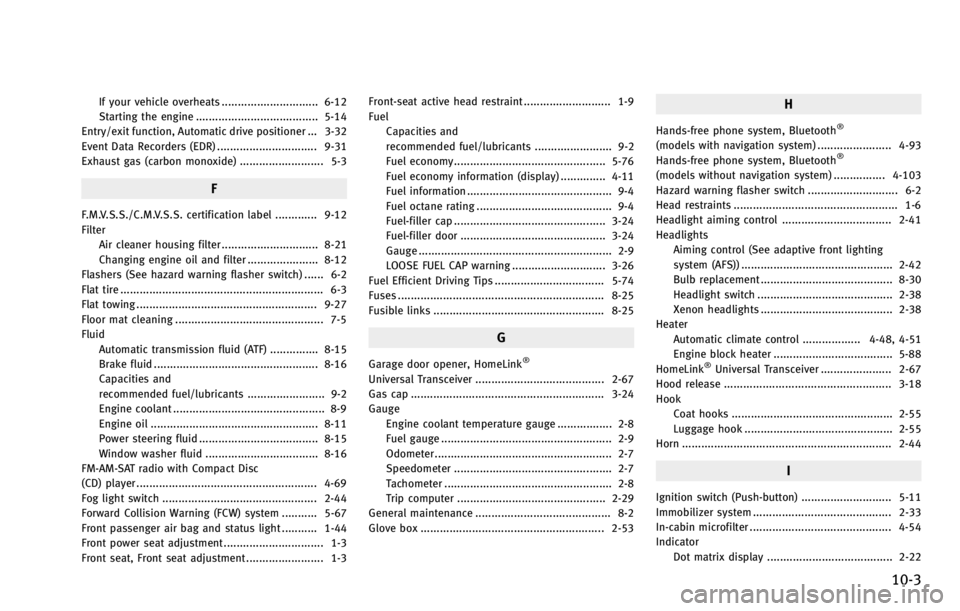engine overheat INFINITI QX70 2014 User Guide
[x] Cancel search | Manufacturer: INFINITI, Model Year: 2014, Model line: QX70, Model: INFINITI QX70 2014Pages: 530, PDF Size: 2.48 MB
Page 452 of 530

SDI2264
1. Fuse/fusible link holder
2. Battery
3. Engine oil filler cap
4. Radiator filler cap
5. Engine oil dipstick
6. Brake fluid reservoir7. Window washer fluid reservoir
8. Power steering fluid reservoir
9. Air cleaner
10. Drive belt location
11. Coolant reservoirThe engine cooling system is filled at the
factory with a pre-diluted mixture of 50%
Genuine NISSAN Long Life Antifreeze/Cool-
ant (blue) and 50% water to provide year-
round anti-freeze and coolant protection.
The antifreeze solution contains rust and
corrosion inhibitors. Additional engine
cooling system additives are not neces-
sary.
WARNING
.
Never remove the radiator or coolant
reservoir cap when the engine is hot.
Wait until the engine and radiator cool
down. Serious burns could be caused by
high pressure fluid escaping from the
radiator. See precautions in “If your
vehicle overheats” (P.6-12) of this man-
ual.
. The radiator is equipped with a pressure
type radiator cap. To prevent engine
damage, use only a genuine NISSAN
radiator cap.
Maintenance and do-it-yourself8-9
ENGINE COOLING SYSTEM
Page 454 of 530

If the cooling system requires coolant
frequently, have it checked by an INFINITI
retailer.
CHANGING ENGINE COOLANT
Major cooling system repairs should be
performed by an INFINITI retailer. The
service procedures can be found in the
appropriate INFINITI Service Manual.
Improper servicing can result in reduced
heater performance and engine overheat-
ing.
WARNING
.To avoid the danger of being scalded,
never change the coolant when the
engine is hot.
. Never remove the radiator cap when the
engine is hot. Serious burns could be
caused by high pressure fluid escaping
from the radiator.
. Avoid direct skin contact with used
coolant. If skin contact is made, wash
thoroughly with soap or hand cleaner as
soon as possible.
. Keep coolant out of the reach of children
and pets.
Engine coolant must be disposed of
properly. Check your local regulations.
SDI2045
VQ37VHR engine
SDI2265
VK50VE engine
Maintenance and do-it-yourself8-11
ENGINE OIL
Page 492 of 530

15%.)
. E-15 fuel contains more than 10%
oxygenate. E-15 fuel will adversely
affect the emission control devices
and systems of the vehicle and should
not be used. Damage caused by such
fuel is not covered by the INFINITI new
vehicle limited warranty.
. If a methanol blend is used, it should
contain no more than 5% methanol
(methyl alcohol, wood alcohol). It
should also contain a suitable amount
of appropriate cosolvents and corro-
sion inhibitors. If not properly formu-
lated with appropriate cosolvents and
corrosion inhibitors, such methanol
blends may cause fuel system damage
and/or vehicle performance problems.
At this time, sufficient data is not
available to ensure that all methanol
blends are suitable for use in INFINITI
vehicles.
If any undesirable driveability problems
such as engine stalling or hard hot starting
are experienced after using oxygenate-
blend fuels, immediately change to a
non-oxygenate fuel or a fuel with a low
blend of MTBE. Take care not to spill gasoline during
refueling. Gasoline containing oxygenates
can cause paint damage.
E-15 fuel
E-15 fuel is a mixture of approximately
15% fuel ethanol and 85% unleaded
gasoline. E-15 can only be used in vehicles
designed to run on E-15 fuel. Do not use E-
15 in your vehicle. U.S. government
regulations require fuel ethanol dispensing
pumps to be identified with small, square,
orange and black label with the common
abbreviation or the appropriate percentage
for that region.
E-85 fuel
E-85 fuel is a mixture of approximately
85% fuel ethanol and 15% unleaded
gasoline. E-85 can only be used in a
Flexible Fuel Vehicle (FFV). Do not use E-
85 fuel in your vehicle. U.S. government
regulations require fuel ethanol dispensing
pumps to be identified by a small, square,
orange and black label with the common
abbreviation or the appropriate percentage
for that region.
Aftermarket fuel additives
INFINITI does not recommend the use of
any aftermarket fuel additives (Example:
fuel injector cleaner, octane booster, intake
valve deposit removers, etc.) which are
sold commercially. Many of these additives
intended for gum, varnish or deposit
removal may contain active solvent or
similar ingredients that can be harmful to
the fuel system and engine.
Octane rating tips
Using unleaded gasoline with an octane
rating lower than recommended above can
cause persistent, heavy spark knock.
(Spark knock is a metallic rapping noise.)
If severe, this can lead to engine damage.
If you detect a persistent heavy spark
knock even when using gasoline of the
stated octane rating, or if you hear steady
spark knock while holding a steady speed
on level roads, have an INFINITI retailer
correct the condition. Failure to correct the
condition is misuse of the vehicle, for
which INFINITI is not responsible.
Incorrect ignition timing will result in
knocking, after-run or overheating. This in
turn may cause excessive fuel consumption
or damage to the engine. If any of the
Technical and consumer information9-5
Page 507 of 530

9-20Technical and consumer information
STI0541
The GCWR equals the combined weight of
the towing vehicle (including passengers
and cargo) plus the total trailer load.
Towing loads greater than these or using
improper towing equipment could ad-
versely affect vehicle handling, braking
and performance.
The ability of your vehicle to tow a trailer is
not only related to the maximum trailer
loads, but also the places you plan to tow.
Tow weights appropriate for level highway
driving may have to be reduced on very
steep grades or for low traction situations
(for example, on slippery boat ramps).
Temperature conditions can also affecttowing. For example, towing a heavy trailer
in high outside temperatures on graded
roads can affect engine performance and
cause overheating. The transmission high
fluid temperature protection mode, which
helps reduce the chance of transmission
damage, could activate and automatically
decrease engine power. Vehicle speed may
decrease under high load. Plan your trip
carefully to account for trailer and vehicle
load, weather and road conditions.
WARNING
Overheating can result in reduced engine
power and vehicle speed. The reduced speed
may be lower than other traffic, which could
increase the chance of a collision. Be
especially careful when driving. If the
vehicle cannot maintain a safe driving
speed, pull to the side of the road in a safe
area. Allow the engine to cool and return to
normal operation. See
“If your vehicle over-
heats” (P.6-12) of this manual.
CAUTION
Vehicle damage resulting from improper
towing procedures are not covered by
INFINITI warranties.
Page 513 of 530

9-26Technical and consumer information
inadvertently becoming unlatched.
. Avoid abrupt starts, acceleration or
stops.
. Avoid sharp turns or lane changes.
. Always drive your vehicle at a moderate
speed. Some states or provinces have
specific speed limits for vehicles that
are towing trailers. Obey the local
speed limits.
. When backing up, hold the bottom of
the steering wheel with one hand.
Move your hand in the direction in
which you want the trailer to go. Make
small corrections and back up slowly. If
possible, have someone guide you
when you are backing up.
Always block the wheels on both vehicle
and trailer when parking. Parking on a
slope is not recommended; however, if you
must do so:
CAUTION
If you move the shift lever to the P (Park)
position before blocking the wheels and
applying the parking brake, transmission
damage could occur.
1. Apply and hold the brake pedal.
2. Have someone place blocks on the downhill side of the vehicle and trailer
wheels.
3. After the wheel blocks are in place, slowly release the brake pedal until the
blocks absorb the vehicle load.
4. Apply the parking brake.
5. Shift the transmission into P (Park).
6. Turn off the engine.
To drive away:
1. Apply and hold the brake pedal.
2. Start the engine.
3. Shift the transmission into gear.
4. Release the parking brake.
5. Drive slowly until the vehicle and trailer are clear from the blocks.
6. Apply and hold the brake pedal.
7. Have someone retrieve and store the blocks.
. When going down a hill, shift into a
lower gear and use the engine braking
effect. When going up a long grade,
downshift the transmission to a lower
gear and reduce speed to reduce
chances of engine overloading and/or overheating.
. If the engine coolant rises to an
extremely high temperature when the
air conditioning system is on, turn off
the air conditioner. Coolant heat can be
additionally vented by opening the
windows, switching the fan control to
high and setting the temperature con-
trol to the HOT position.
. Trailer towing requires more fuel than
normal circumstances.
. Avoid towing a trailer for the first 500
miles (800 km).
. Have your vehicle serviced more often
than at intervals specified in the
recommended maintenance schedule
in the INFINITI Service and Maintenance
Guide.
. When making a turn, your trailer wheels
will be closer to the inside of the turn
than your vehicle wheels. To compen-
sate for this, make a larger than normal
turning radius during the turn.
. Crosswinds and rough roads will ad-
versely affect vehicle/trailer handling,
possibly causing vehicle sway. When
being passed by larger vehicles, be
prepared for possible changes in cross-
winds that could affect vehicle hand-
Page 514 of 530

ling. If swaying does occur, firmly grip
the steering wheel, steer straight
ahead, and immediately (but gradually)
reduce vehicle speed. This combination
will help stabilize the vehicle. Never
increase speed.
Do the following if the trailer begins to
sway:
1. Take your foot off the accelerator pedal to allow the vehicle to coast and steer
as straight ahead as the road condi-
tions allow. This combination will help
stabilize the vehicle.
.Do not correct trailer sway by steer-ing or applying the brakes.
2. When the trailer sway stops, gently apply the brakes and pull to the side of
the road in a safe area.
3. Try to rearrange the trailer load so it is balanced as described earlier in this
section.
. Be careful when passing other vehicles.
Passing while towing a trailer requires
considerably more distance than nor-
mal passing. Remember the length of
the trailer must also pass the other
vehicle before you can safely change
lanes. .
Down shift the transmission to a lower
gear for engine braking when driving
down steep or long hills. This will help
slow the vehicle without applying the
brakes.
. Avoid holding the brake pedal down too
long or too frequently. This could cause
the brakes to overheat, resulting in
reduced braking efficiency.
. Increase your following distance to
allow for greater stopping distances
while towing a trailer. Anticipate stops
and brake gradually.
. Do not use cruise control while towing a
trailer.
. Some states or provinces have specific
regulations and speed limits for vehi-
cles that are towing trailers. Obey the
local speed limits.
. Check your hitch, trailer wiring harness
connections, and trailer wheel lug nuts
after 50 miles (80 km) of travel and at
every break.
. When stopped in traffic for long periods
of time in hot weather, put the vehicle
in the P (Park) position.
. When launching a boat, don’t allow the
water level to go over the exhaust tail
pipe or rear bumper. .
Make sure you disconnect the trailer
lights before backing the trailer into the
water or the trailer lights may burn out.
When towing a trailer, the transmission
fluid should be changed more frequently.
For additional information, see the “8.
Maintenance and do-it-yourself” section
earlier in this manual.
FLAT TOWING
Towing your vehicle with all four wheels on
the ground is sometimes called flat towing.
This method is sometimes used when
towing a vehicle behind a recreational
vehicle, such as a motor home.
CAUTION
. Failure to follow these guidelines can
result in severe transmission damage.
. Whenever flat towing your vehicle, al-
ways tow forward, never backward.
. DO NOT tow any automatic transmission
vehicle with all four wheels on the
ground (flat towing). Doing so WILL
DAMAGE internal transmission parts
due to lack of transmission lubrication.
Technical and consumer information9-27
Page 522 of 530

If your vehicle overheats .............................. 6-12
Starting the engine ...................................... 5-14
Entry/exit function, Automatic drive positioner ... 3-32
Event Data Recorders (EDR) ............................... 9-31
Exhaust gas (carbon monoxide) .......................... 5-3
F
F.M.V.S.S./C.M.V.S.S. certification label ............. 9-12
Filter
Air cleaner housing filter .............................. 8-21
Changing engine oil and filter ...................... 8-12
Flashers (See hazard warning flasher switch) ...... 6-2
Flat tire ............................................................... 6-3
Flat towing ........................................................ 9-27
Floor mat cleaning .............................................. 7-5
Fluid Automatic transmission fluid (ATF) ............... 8-15
Brake fluid ................................................... 8-16
Capacities and
recommended fuel/lubricants ........................ 9-2
Engine coolant ............................................... 8-9
Engine oil .................................................... 8-11
Power steering fluid ..................................... 8-15
Window washer fluid ................................... 8-16
FM-AM-SAT radio with Compact Disc
(CD) player ........................................................ 4-69
Fog light switch ................................................ 2-44
Forward Collision Warning (FCW) system ........... 5-67
Front passenger air bag and status light ........... 1-44
Front power seat adjustment ............................... 1-3
Front seat, Front seat adjustment ........................ 1-3 Front-seat active head restraint ........................... 1-9
Fuel
Capacities and
recommended fuel/lubricants ........................ 9-2
Fuel economy............................................... 5-76
Fuel economy information (display) .............. 4-11
Fuel information ............................................. 9-4
Fuel octane rating .......................................... 9-4
Fuel-filler cap ............................................... 3-24
Fuel-filler door ............................................. 3-24
Gauge ............................................................ 2-9
LOOSE FUEL CAP warning ............................. 3-26
Fuel Efficient Driving Tips .................................. 5-74
Fuses ................................................................ 8-25
Fusible links ..................................................... 8-25
G
Garage door opener, HomeLink®
Universal Transceiver ........................................ 2-67
Gas cap ............................................................ 3-24
Gauge
Engine coolant temperature gauge ................. 2-8
Fuel gauge ..................................................... 2-9
Odometer....................................................... 2-7
Speedometer ................................................. 2-7
Tachometer .................................................... 2-8
Trip computer .............................................. 2-29
General maintenance .......................................... 8-2
Glove box ......................................................... 2-53
H
Hands-free phone system, Bluetooth®
(models with navigation system) ....................... 4-93
Hands-free phone system, Bluetooth®
(models without navigation system) ................ 4-103
Hazard warning flasher switch ............................ 6-2
Head restraints ................................................... 1-6
Headlight aiming control .................................. 2-41
Headlights Aiming control (See adaptive front lighting
system (AFS)) ............................................... 2-42
Bulb replacement ......................................... 8-30
Headlight switch .......................................... 2-38
Xenon headlights ......................................... 2-38
Heater
Automatic climate control .................. 4-48, 4-51
Engine block heater ..................................... 5-88
HomeLink
®Universal Transceiver ...................... 2-67
Hood release .................................................... 3-18
Hook Coat hooks .................................................. 2-55
Luggage hook .............................................. 2-55
Horn ................................................................. 2-44
I
Ignition switch (Push-button) ............................ 5-11
Immobilizer system ........................................... 2-33
In-cabin microfilter ............................................ 4-54
Indicator
Dot matrix display ....................................... 2-22
10-3
Page 524 of 530

Low washer fluid warning ................................. 2-26
Luggage hooks ................................................. 2-55
M
MaintenanceBattery ......................................................... 8-17
General maintenance ..................................... 8-2
Indicators for maintenance ........................... 2-27
Inside the vehicle .......................................... 8-3
Maintenance precautions ............................... 8-5
Maintenance requirements ............................. 8-2
Outside the vehicle ........................................ 8-2
Seat belt maintenance ................................. 1-17
Malfunction indicator light (MIL) ....................... 2-20
Map lights ........................................................ 2-64
Master warning light ......................................... 2-18
Mechanical key (Intelligent Key system) .............. 3-3
Memory storage, Automatic drive positioner ..... 3-34
Meter, Trip computer ......................................... 2-29
Meters and gauges ............................................. 2-6 Instrument brightness control ...................... 2-43
Mirror Inside mirror ................................................ 3-29
Outside mirrors ............................................ 3-30
Vanity mirror ................................................ 3-32
Monitor, Rearview monitor ................................ 4-24
Moonroof .......................................................... 2-62
N
Net, Cargo net .................................................. 2-56
New vehicle break-in ......................................... 5-74
No key warning ................................................. 2-25
O
Odometer............................................................ 2-7
Off-road recovery ................................................ 5-7
Oil Capacities and
recommended fuel/lubricants ........................ 9-2
Changing engine oil and filter ...................... 8-12
Checking engine oil level ............................. 8-12
Engine oil .................................................... 8-11
Engine oil viscosity ........................................ 9-7
Oil filter replacement indicator ..................... 2-27
Operation, Indicators for operation ................... 2-25
Outside air temperature .................................... 2-30
Outside mirrors ................................................. 3-30
Overheat, If your vehicle overheats ................... 6-12
Owner’s Manual/Service Manual
order information .............................................. 9-32
P
Panic alarm ...................................................... 3-16
Parking Brake break-in ............................................. 5-80
Parking brake operation ............................... 5-20
Parking brake release warning ..................... 2-25 Parking on hills ........................................... 5-78
Personal lights .................................................. 2-65
Phone Bluetooth
®hands-free phone system
(models with navigation system) .................. 4-93
Bluetooth
®hands-free phone system
(models without navigation system) ........... 4-103
Car phone or CB radio ................................. 4-92
Power Front seat adjustment .................................... 1-3
Power door lock ............................................. 3-4
Power outlet ................................................ 2-50
Power steering fluid ..................................... 8-15
Power steering system ................................. 5-79
Power windows ............................................ 2-60
Precautions
Audio operation ........................................... 4-54
Braking precautions ..................................... 5-80
Child restraints ............................................ 1-20
Cruise control .............................................. 5-30
Driving safety ................................................. 5-9
Lane departure warning (LDW) system ......... 5-22
Maintenance .................................................. 8-5
On-pavement and off-road driving .................. 5-7
Seat belt usage ........................................... 1-11Supplemental restraint system ..................... 1-37
When starting and driving .............................. 5-3
Pre-crash seat belts with comfort function ........ 1-13
Preview function ............................................... 5-81
Preview function (for Intelligent cruise
control system) ................................................. 5-54
10-5